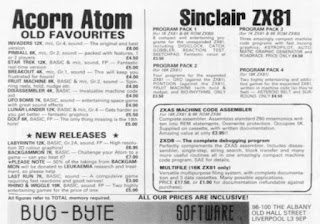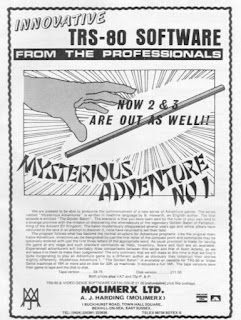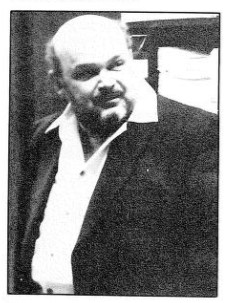1 Buckhurst Road, Town Hall Square, Bexhill
There's not a huge amount of information about Molimerx online. @ZXadventurer on Twitter has put together a comprehensive page at Molimerx's Mysterious Adventures. They found several sources which I wouldn't otherwise have located and their page should be the first port of call for anyone interested in information about Molimerx and Brian Howarth; who wrote ten text adventures for Molimerx and went on to found his own company, Digital Fantasia, and also write games for Adventure International (UK).
Molimerx is remarkably resistant to internet searches which is odd considering their distinctive name. There's no record at Companies House. Molimerx adverts listed the company as A J Harding (Molimerx) which made me wonder if the company was registered under A J Harding's name but again, I can't track anything down. Several websites conflate Molimerx games with later ones by other companies. Brian Howarth released conversions of his Molimerx adventures under the Digital Fantasia name, and these conversions are often flagged as Molimerx titles (they are not, unless anyone know differently?). There's also a 1983 Molimerx game called Interdictor Pilot, by Laurence Marshall who also wrote the later Amstrad and Commodore 64 versions. The Amstrad and C64 titles are again often flagged as Molimerx games but were published by Supersoft. Now, Supersoft turn out to be a company with almost as long a history as Molimerx but that's a story for another time. I mention all this just to whine, a bit.
Going back and looking through that first issue of C&VG more attentively it becomes clear why the Molimerx advert stands out. Most of the adverts are for hardware, rather than software, and the few software company adverts tend to look like this.
 |
| C&VG November 1981 Page 7 |
Bug-Byte were a year old at this point and had just, more or less, made the leap from profitable hobby to full time business and set up in offices in Liverpool. Their advert is typical of most software houses at the time, a small and cluttered half-page advert which tries to get value for money by cramming in as many programmes for sale as possible. It looks more like a Classified Ads page.
 |
| C&VG November 1981 Page 6 |
In contrast, the double-page Molimerx advert is clean and easy on the eye; although the wall of text at the bottom does distract somewhat. It's primitive but it has much more in common with the glossy game adverts that will start to appear after 1983 and the rise of Imagine. There are a couple of reasons why my gaze slid off this advert when I first saw it. Partly because everything I know about the TRS-80 can be written, well, here in the section at the bottom of that page, about The Computers that Saved Metropolis. A weird advertorial comic about two plucky kids and their TRS-80 who help Superman defeat three plots by a bloke called Major Disaster (that's original).
28 Collington Avenue, Bexhill, East Sussex
PERSONAL COMPUTER WORLD issue one, "Europe's first magazine for personal computers for home and business use," was published in February 1978. A J Harding, the owner of Molimerx, makes his first appearance in issue 4, August 1978, with a report on, "the first of the new breed of microcomputers which is now becoming available to the home and small business user." You won't be surprised to hear this computer is the TRS-80. Mr Harding is back in October 1978
"TRS-80 Software is now available from A. J. Harding of Bexhill. This includes all types of programmes for the TRS-80, ranging from games to business software. Mr Harding, the U.K. director of J. & J. Electronics Ltd., Canadian mail order semiconductor distributors, has available both programs imported from the U.S.A. and programs from English authors. Having been involved with Micro processors from their inception in North America and being one of the earlier purchasers of TRS-80 equipment, Mr Harding is in a good position to bring to this country a good assortment of software. An SAE will bring you his list"
* with a TRS-80 type-in programme called Submarine Chase. He's then back again twice in the December 1978 issue with two small adverts.
 |
| Page 8 |
 |
| Page 68 |
There are a few software company adverts in the December 1978 issue. What sets A.J. Harding's advert apart is a single word; games. It's probably about as close as you can get to seeing the birth of the British games industry. Still let's not get too patriotic. There are a lot more baby steps to get through. A J Harding's company doesn't even have a name, yet. The February 1979 issue goes into a little more detail and gives a thumbnail description of the company:
 |
| PERSONAL COMPUTER WORLD July 1979 page 30 |
There's also a small boxed advert at the bottom right of the page. It lists four games for sale Microchess, Star Trek, Slot Machine, and Space Fighter. A J Harding's company becomes a monthly presence in PERSONAL COMPUTER WORLD for the rest of the year, and you can see the company develop on a month by month basis as the adverts become more sophisticated. Molimerx finally gets its name in July 1979.
 |
| PERSONAL COMPUTER WORLD September 1979 page 91 |
September 1979 sees Molimerx adverts in close to their final form. The company has gained a logo, a shape which looks like a head wearing a crown and is also the letters A J H and M overprinted. The advert takes up a half-page, full page adverts won't come along until February 1980; for context, the Sinclair ZX80 was released, 29th January 1980. The February 1980 advert also carries the following text:
"ADVENTURE
The original Adventure was written for a main frame computer and was called Adventureland. Since then there have been many derivatives. The best are written in machine code like the Scott Adams series (for which label we happen to be the sole importers!), but good as they are they, they have to be shortened to fit into 16k. This Microsoft Adventure is the original uncut main frame version, for the first time available for a microcomputer."
The original Adventure was written for a main frame computer and was called Adventureland. Since then there have been many derivatives. The best are written in machine code like the Scott Adams series (for which label we happen to be the sole importers!), but good as they are they, they have to be shortened to fit into 16k. This Microsoft Adventure is the original uncut main frame version, for the first time available for a microcomputer."
That's Microsoft as in The Microsoft, they released Adventure in 1979 for the TRS-80 and the Apple II through its division, Microsoft Consumer Products. Molimerx also distributed Microsoft's Level IV BASIC and won a successful case against Kansas City Systems, of Chesterfield, who were importing and selling the software without a licence. This was reported as an early victory in recognising that software could be protected by copyright (INFOWORLD, December 22 1980 page 1), something which wouldn't actually become law until 1985. I keep coming back to this sense that Molimerx was the UK software industry in miniature; running professional advertising campaigns, importing software from America, establishing points of law. Better known companies would reinvent all this later in the eighties. Molimerx was, at this point, still being run from A. J. Harding's house at 28 Collington Avenue, Bexhill, a respectable looking house set back from a busy road in Bexhill, but the company was about to move.
1 Buckhurst Road, Town Hall Square, Bexhill
 |
| July 2022 |
Molimerx settled into a comfortable niche. May 1981 saw them release Mysterious Adventure. The first game from Brian Howarth. December 1982 sees them publish a TRS-80 version of Penetrator from Beam Software/Melbourne House and advertise it using the familiar logo.
 |
| Spot the difference TRS-80 title screen, left. ZX Spectrum title screen, right |
There's a 1982 Melbourne House catalogue which lists the TRS-80 version of Penetrator, along with Strike Force, also mentioned in the December 1982 advert, and four other games; Martian Patrol, Wild West, Grand Prix, and Space Attack. The catalogue ends with a note that, "All our TRS80 software is available in the UK from John Harding (Molimerx ) Ltd. Molimerx can be contacted on 0424-220391." A J Harding finally gets a name.
1982 turns into 1983. Brian Howarth sets up Digital Fantasia to port his games to other computers around the same time Molimerx finally acknowledges the existence of non TRS-80 hardware with an excitable advert announcing that "MOLIMERX EXPANDS INTO THE BBC." ACORN USER (June 1983 page 17). The company seems to do all its news and PR via these full page adverts. Treating them as a substitute for the relationship most companies wanted to form with computer magazines. It's rare to find much non-advert coverage about Molimerx, outside of C&VG. So how did the company do business? The ACORN USER advert explains:
"Over the years Molimerx have built up a catalogue of 170 pages. The procedure is that an addition containing new software is published every 8 weeks or so. The existing index is discarded and the new addition contains a new up-dated index. The catalogue is punched for a ring binder; hence customers always have a current and up to date catalogue."
This is a charmingly old-school way of doing business. Why issue press releases and spend money on massive campaigns when your customers are all on your mailing list and have a huge, constantly up to date catalogue to browse. You can read an example of the catalogue here.
Molymerx's Mysterious Adventures links to the website of Marion Harding, which has subsequently fallen off the internet but is archived at The Wayback Machine. It includes a very brief section about Molimerx:
"In 1976 John and Marion were back in England at the outset of the computer industry. They set up England's first and largest computer software company; Molimerx Ltd. The company went onto publish over 600 programs and books and at their zenith had 150 programmers under contract including Brian Howarth. As well as dealing personally with noted luminaries in the industry including Bill Gates, Lord Alan Sugar and Sir Clive Sinclair, Molimerx also undertook large scale custom programs for multi-nationals including Esso."
This is all makes a little more sense of Molimerx's business plan, which I've struggled to understand. The company is obviously ambitious and successful and yet through 1981 and 1982 they ignore the launch of computers by Acorn, Commodore, Dragon, and Sinclair, all of which could have grown their business. It sounds as if the company's main business was elsewhere and the software line was just a nice side hustle.
 |
| 80-US February 1983 page 110 |
"I was a lawyer in England and trained in electronics in the Air Force. My wife is Canadian and while living there, I decided to set up an electronics company called J&J 110 80-U.S. Journal
Electronics. We sold semi- conductors and the market was right. It took off and is still succeeding. I gave up law and was making money selling electronic parts. Around 1973, we restructured the company so we could return to England and run it from there. We structured it so well, there was little to do but make decisions and sign checks. I got myself a little Tandy to play around with and from there it's the same story as anybody else. While living in Canada, I met a number of people in the States, so I asked a few to send over some software, perhaps I could sell it. And from there it's now a big international company."
The interview ends on the intriguing note. It was halted because "it was time for a poker game to begin."
1983 seems to be the peak year for Molimerx. Typing the company name into the search box at the Computer Magazines archive gives 57 results for 1983, falling back to 27 in 1984, and 4 in 1985; although this is obviously not a hugely scientific metric. The company's distinctive full-page adverts disappear after 1983, but as we've seen the company had an effective way of speaking directly to its customers; so maybe adverts weren't regarded as necessary. Then in 1984 John, or rather A J Harding as he is credited, has a book published by Virgin books, Writing Software for Profit. SINCLAIR USER printed a review in the January 1985 issue (page 133) .
"The advice given is that of a software publisher as Harding knows the business inside out. He has been in it six years as director of a software house.
The first section of the book describes the industry, how it has grown and the type of people who are involved in it. It covers mostly the upper, business, end of the market but the innovations shown by Tandy and Commodore are equally true of the smaller outfits attached to the home market.
Harding explains that professional authors write for chips and not for specific machines. In that way one program can be adapted for a wide variety of micros which contain the same chip. For instance, a game written for the 6502 could be easily run on the BBC Micro and the Commodore range of machines. A Z80 game could be transported across a wide variety of machines including Spectrum and Colour Genie."
That last paragraph is logical but confusing because that wasn't how Molimerx operated. The Tandy TRS-80 used a Zilog Z80 processor, as did the NASCOM machines, the Amstrad computers, and Sinclair's ZX80, ZX81, and Spectrum. Molimerx ignored those machines even as markets sprung up around them, hungry for software. Perhaps the book was written from the perspective of someone who wished they had followed their own advice. The review ends on a no nonsense note which probably sums up John Harding's attitude:
"[The book] might deter some from writing software but those are likely to be the ones who demand attention for their masterpieces which are sent in as miles of computer printer listing. As the book says computers mean business."
Then, in August 1987, C&VG reported Molimerx were closing down:
"After nearly ten years selling software, Molimerx based in Sussex, is closing down In the heyday of early home computers, the name Molimerx was a byword to owners of Tandy machines. Having the sole right to distribute Adventure International products. Molimerx introduced many computer enthusiasts to Scott Adams' adventures.
As well as importing programs, Molimerx had a number of its own authors — people who had written programs and submitted them for publication. Among these were Brian Howarth, whose famous Mysterious Adventures were given a start in life by Molimerx, and none other than Keith Campbell, author of three BASIC adventures.
Terry Pratt, founder editor of C+VG, approached Molimerx during the planning stage of the first issue, seeking potential writers on adventure games. It was thus through them that C+VG's adventure column came to be written by [Keith Campbell] and still is to this day."
Molimerx closed with little fuss. Today the company doesn't even have it's own Wikipedia page. Normally I like to open these blog entries with the cover of a game associated with the company, I can't really do that with Molimerx because very little of their catalogue has survived. What has, is archived over at the Molimerx's Mysterious Adventures page and you should really view it there. Maybe this obscurity is a reflection of the way Molimerx positioned itself in the industry, a pioneer but not a leader, off to one side rather than at the front.
* The scanning goes a bit weird, so page 24 comes before page 23 and the article doesn't make sense.
Unprecedented celebrations in the stinking editorial garret of Where Were They Now. A flurry of interest saw our Twitter follower count skyrocket to 32. Join us. Join us, @ShamMountebank, or leave a comment, or (if it turns out Molimerx wasn't quite as unknown as I thought) email whereweretheynow@gmail.com







No comments:
Post a Comment